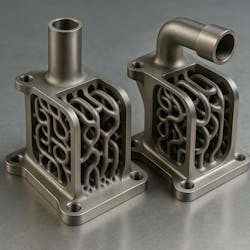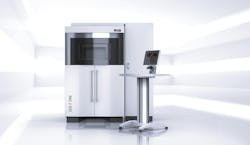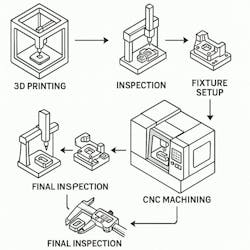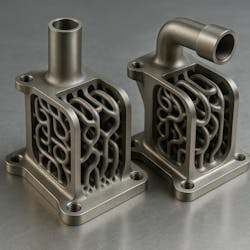How Hybrid Manufacturing Combines CNC and 3D Printing for Accelerated Product Development
At a Glance:
- What’s the difference between additive manufacturing and subtractive manufacturing?
- When should companies take advantage of a hybrid approach?
CNC or 3D printing? Why not both? Hybrid approaches combine subtractive and additive manufacturing processes to deliver precise outputs at greater speeds.
In this piece, we’ll break down the basics of building up and breaking down materials to arrive at finished products. We’ll speak to the benefits of each manufacturing type and explore how taking a tandem approach can help benefit your business.
Understanding Additive and Subtractive Manufacturing
Additive manufacturing adds materials layer by layer to produce a finished product. It is more commonly called 3D printing because, much like a traditional printer, it uses a digital design template as the basis for its output.
There are multiple types of 3D printing, such as selective laser sintering (SLS), multi-jet fusion (MJF) and fused deposition modeling (FDM). While each has unique benefits—for example, SLS makes it possible to print complex internal geometries without supports, while MJF offers superior detail resolution—the core concept remains the same. Material is added to produce the end result.
Subtractive manufacturing is the process of removing material from a solid object to create the desired result. Computer numerical control (CNC) is one popular form of subtractive manufacturing.
For example, companies might start with a solid block or bar of material. Subtractive processes remove specific parts of this material to produce the desired output. Techniques used to achieve this aim include milling, grinding, turning and boring.
Hybrid manufacturing is the combination of additive and subtractive processes to get the best of both worlds.
Additive Advantages
There are multiple advantages of additive approaches, including:
- Speed. Simple shapes are easy for additive solutions, making them quick to produce. This is ideal for parts that don’t require additional machining or post-processing to improve finish or fit. For example, the consistency of MJF layer-by-layer fusion makes it ideal for medium- to high-volume production of highly standardized parts.
- Customization. Additive manufacturing also enables parts customization. Companies are not bound by the geometry of starting objects. Instead, they can create and modify whatever shape their application requires. Solutions such as SLS offer the ability to create complex internal geometries using high-strength thermoplastic parts. The ease of customization in 3D printing also lets teams easily iterate new parts and try out new ideas with minimal waste.
- Cost control. Additive tools use exact material amounts. Companies can specify exactly how much plastic, metal or ceramic is used in a specific design. While some waste still occurs as parts are layered and connected, this waste is minimal compared to subtractive manufacturing.
It’s worth noting that there are potential drawbacks to additive processes. For example, complex geometries can occasionally cause failed outputs, requiring time and effort to fix. In addition, many 3D printed parts require additional finishing before they can be used in practical applications.
Subtractive Solutions
Subtractive solutions help companies solve several challenges, such as:
- Precision. CNC and similar tools excel at creating forms with precise angles and joints that easily fit together with other parts. This precision means minimal post-processing is required, even for complex outputs.
- Material finish. Subtractive tools also provide customizable material finishes. By precisely cutting surfaces, these solutions can create smooth, rough sinuous or other material finishes for specific applications. Consistency. Because material is being removed rather than added, subtractive tools often produce more consistent results than their 3D printed counterparts. While they can’t keep pace when it comes to speed, subtractive processes are often preferred for applications with low-fault tolerance.
Doing the Math: The Benefits of a Hybrid Approach
Depending on the nature of your industry and the complexity of your designs, your business may benefit from primary subtractive or largely additive frameworks. In many cases, however, companies can see significant advantages by combining some aspects of each manufacturing type.
First is improved finish with lower material waste. While CNC processes are known for their precision, the nature of subtractive manufacturing means that this precision comes at the cost of material. Additive processes, meanwhile, let companies precisely control the amount of material used to create a product.
In a hybrid approach, 3D printing processes are used to create parts or components that contain small amounts of excess material in areas that require precise finishing. CNC tools then remove this material to create optimized designs with minimal material waste.
Other hybrid benefits include:
- Improved production timelines. Additive processes are ideal for rapid prototyping and quick test runs. This lets companies dial in ideal specifications and geometries before moving into large-scale production runs. Subtractive approaches, meanwhile, excel at finishing touches. The result? By producing parts in bulk using 3D printing and finishing them with CNC tools, manufacturers can improve production timelines without sacrificing precision.
- Enhanced design freedom. The combination of additive and subtractive manufacturing enables design freedom. As noted above, 3D printing makes it possible to create almost any form. Where this process falls short, however, is in the details.
Using exclusively additive processes means companies are limited by the ability of 3D printers to create precise shapes and finishes. Integrating subtractive tools allows teams to extend the impact of additive solutions. For example, parts can be 90% completed with printing processes and then sent to CNC machines for finishing. This tandem approach allows companies to leverage the benefits and avoid the drawbacks of both methods.
Multiplied Manufacturing—Faster, Stronger, Simpler
Combining additive and subtractive manufacturing multiplies their impact if companies can create and implement an effective hybrid approach. This starts by working with 3D printing companies that offer both well-known and cutting-edge additive solutions.
Next is the development of a hybrid strategy, which lets CNC and 3D printing do what they do best and overlapping their outputs where it makes the most sense. In practice, this often means using 3D solutions to iterate and test new part designs and leveraging CNC technologies to deliver improved finishes.
When it comes to a hybrid manufacturing approach, there’s no “right” answer. Some businesses are better served by primarily subtractive processes, while others have production lines that align with additive solutions.
The bottom line? Find the balance that suits your business to accelerate product design, development and delivery.
About the Author
Patrick Wirt
Founder, Forge Labs
Patrick Wirt is founder of Forge Labs, a digital manufacturing company specializing in additive manufacturing and 3D printing. Wirt has worked with small to large organizations across Canada and the U.S., helping implement cutting-edge manufacturing technologies and software to streamline production, enhance scalability and drive innovation.



